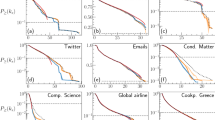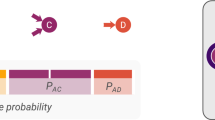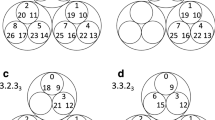Abstract
Due to its ease of use, as well as its enormous flexibility in its degree structure, the configuration model has become the network model of choice in many disciplines. It has the wonderful property, that, conditioned on being simple, it is a uniform random graph with the prescribed degrees. This is a beautiful example of a general technique called the probabilistic method that was pioneered by Erdős. It allows us to count rather precisely how many graphs there are with various degree structures. As a result, the configuration model is often used as a null model in network theory, so as to compare real-world network data to. When the degrees are sufficiently light-tailed, the asymptotic probability of simplicity for the configuration model can be explicitly computed. Unfortunately, when the degrees vary rather extensively and vertices with very high degrees are present, this method fails. Since such degree sequences are frequently reported in empirical work, this is a major caveat in network theory.
In this survey, we discuss recent results for the configuration model, including asymptotic results for typical distances in the graph, asymptotics for the number of self-loops and multiple edges in the finite-variance case. We also discuss a possible fix to the problem of non-simplicity, and what the effect of this fix is on several graph statistics. Further, we discuss a generalization of the configuration model that allows for the inclusion of community structures. This model removes the flaw of the locally tree-like nature of the configuration model, and gives a much improved fit to real-world networks.
Access this chapter
Tax calculation will be finalised at checkout
Purchases are for personal use only
Similar content being viewed by others
References
Angel, O., van der Hofstad, R., Holmgren, C.: Limit laws for self-loops and multiple edges in the configuration model. arXiv:1603.07172 [math.PR], Preprint (2016)
Barabási, A.-L., Albert, R.: Emergence of scaling in random networks. Science 286(5439), 509–512 (1999)
Bender, E., Canfield, E.: The asymptotic number of labelled graphs with given degree sequences. J. Comb. Theory (A) 24, 296–307 (1978)
Bollobás, B.: A probabilistic proof of an asymptotic formula for the number of labelled regular graphs. Eur. J. Comb. 1(4), 311–316 (1980)
Bollobás, B.: Random Graphs. Cambridge Studies in Advanced Mathematics, vol. 73, 2nd edn. Cambridge University Press, Cambridge (2001)
Bollobás, B., Riordan, O., Spencer, J., Tusnády, G.: The degree sequence of a scale-free random graph process. Random Struct. Algorithms 18(3), 279–290 (2001)
Britton, T., Deijfen, M., Martin-Löf, A.: Generating simple random graphs with prescribed degree distribution. J. Stat. Phys. 124(6), 1377–1397 (2006)
Durrett, R.: Random Graph Dynamics. Cambridge Series in Statistical and Probabilistic Mathematics. Cambridge University Press, Cambridge (2007)
Erdős, P.: Some remarks on the theory of graphs. Bull. Am. Math. Soc. 53, 292–294 (1947)
Erdős, P., Gallai, T.: Graphs with points of prescribed degrees. Mat. Lapok 11, 264–274 (1960). (Hungarian)
Erdős, P., Rényi, A.: On random graphs I. Publ. Math. Debrecen 6, 290–297 (1959)
Erdős, P., Rényi, A.: On the evolution of random graphs. Magyar Tud. Akad. Mat. Kutató Int. Közl. 5, 17–61 (1960)
Erdős, P., Rényi, A.: On the evolution of random graphs. Bull. Inst. Int. Stat. 38, 343–347 (1961)
Erdős, P., Rényi, A.: On the strength of connectedness of a random graph. Acta Math. Acad. Sci. Hungar. 12, 261–267 (1961)
Faloutsos, C., Faloutsos, P., Faloutsos, M.: On power-law relationships of the internet topology. Comput. Commun. Rev. 29, 251–262 (1999)
Federico, L., van der Hofstad, R.: Critical window for connectivity in the configuration model. Combin. Probab. Comput. 26(5), 660–680 (2017)
Gao, P., Wormald, N.: Enumeration of graphs with a heavy-tailed degree sequence. Adv. Math. 287, 412–450 (2016)
Gilbert, E.N.: Random graphs. Ann. Math. Stat. 30, 1141–1144 (1959)
van der Hofstad, R.: Random graphs and complex networks. Cambridge Series in Statistical and Probabilistic Mathematics, vol. 1. Cambridge University Press, Cambridge (2017)
van der Hofstad, R.: Random graphs and complex networks, vol. 2 (2018+). In preparation, see http://www.win.tue.nl/~rhofstad/NotesRGCNII.pdf
van der Hofstad, R., Hooghiemstra, G., Van Mieghem, P.: Distances in random graphs with finite variance degrees. Random Struct. Algorithms 27(1), 76–123 (2005)
van der Hofstad, R., Hooghiemstra, G., Znamenski, D.: Distances in random graphs with finite mean and infinite variance degrees. Electron. J. Probab. 12(25), 703–766 (2007). (Electronic)
van der Hofstad, R., van Leeuwaarden, J., Stegehuis, C.: Hierarchical configuration model. arXiv:1512.08397 [math.PR], Preprint (2015)
Janson, S., Luczak, M.: A new approach to the Giant component problem. Random Struct. Algorithms 34(2), 197–216 (2009)
Kleinberg, J.M.: Navigation in a small world. Nature 406, 845 (2000)
Kleinberg, J.M.: The small-world phenomenon: an algorithm perspective. In: Proceedings of the Twenty-Third Annual ACM Symposium on Principles of Distributed Computing, pp. 163–170, May 2000
Krioukov, D., Kitsak, M., Sinkovits, R., Rideout, D., Meyer, D., Boguñá, M.: Network cosmology. Sci. Rep. 2, Article number 793 (2012)
Leskovec, J., Lang, K., Dasgupta, A., Mahoney, M.: Community structure in large networks: natural cluster sizes and the absence of large well-defined clusters. Internet Math. 6(1), 29–123 (2009)
Molloy, M., Reed, B.: A critical point for random graphs with a given degree sequence. Random Struct. Algorithms 6(2–3), 161–179 (1995)
Molloy, M., Reed, B.: The size of the Giant component of a random graph with a given degree sequence. Comb. Probab. Comput. 7(3), 295–305 (1998)
Newman, M.E.J.: Networks: An Introduction. Oxford University Press, Oxford (2010)
Newman, M.E.J., Watts, D.: Scaling and percolation in the small-world network model. Phys. Rev. E 60, 7332–7344 (1999)
Stegehuis, C., van der Hofstad, R., van Leeuwaarden, J.: Epidemic spreading on complex networks with community structures. Sci. Rep. 6, 29748 (2016)
Stegehuis, C., van der Hofstad, R., van Leeuwaarden, J.: Power-law relations in random networks with communities. Phys. Rev. E 94, 012302 (2016)
Watts, D.J.: Small Worlds. The Dynamics of Networks Between Order and Randomness. Princeton Studies in Complexity. Princeton University Press, Princeton (1999)
Watts, D.J., Strogatz, S.H.: Collective dynamics of ‘small-world’ networks. Nature 393, 440–442 (1998)
Acknowledgement
This work is supported by the Netherlands Organisation for Scientific Research (NWO) through VICI grant 639.033.806 and the Gravitation Networks grant 024.002.003. This work has been for the 43rd International Workshop on Graph-Theoretic Concepts in Computer Science WG2017, held from June 21–23, 2017 in Heeze. RvdH thanks the organisors for giving him the opportunity to speak there.
Author information
Authors and Affiliations
Corresponding author
Editor information
Editors and Affiliations
Rights and permissions
Copyright information
© 2017 Springer International Publishing AG
About this paper
Cite this paper
van der Hofstad, R. (2017). Counting Graphs and Null Models of Complex Networks: Configuration Model and Extensions. In: Bodlaender, H., Woeginger, G. (eds) Graph-Theoretic Concepts in Computer Science. WG 2017. Lecture Notes in Computer Science(), vol 10520. Springer, Cham. https://doi.org/10.1007/978-3-319-68705-6_1
Download citation
DOI: https://doi.org/10.1007/978-3-319-68705-6_1
Published:
Publisher Name: Springer, Cham
Print ISBN: 978-3-319-68704-9
Online ISBN: 978-3-319-68705-6
eBook Packages: Computer ScienceComputer Science (R0)




